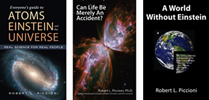|
|
Have We Hit Bottom Yet?
|
Most
physicists believe we have already discovered the smallest particles
that exist, the basic building blocks of nature. However, this isn’t
the first time scientists thought they’d reached bottom, the ultimate
limit of minuteness.
The ancient Greeks believed everything was made from four constituents: air, water, fire, and earth. How primitive.
Later, people believed everything was made of atoms of 92 different elements.
Then science discovered atoms had two parts: nuclei surrounded by electrons.
After that, we learned that nuclei were made of protons and neutrons.
And even later, physicists decided those were probably made of “up” and
“down” quarks.
But more particles were discovered, ultimately leading to a final tally
of 16 “fundamental” particles that comprise nature’s irreducible pieces
that are believed to have zero size and no internal structure.
Everything else we see around us is made of combinations of these
fundamental particles.
Oops, with the discovery of the Higgs boson, let’s make that 17
fundamental particles. Oh, and 12 of the 17 particles have
corresponding antiparticles; the other 5 are their own antiparticles.
To recap: in 25 centuries of peeling layer after layer of the cosmic
onion, we’ve gone from 4 basic building blocks, to 92, to 2, to 3, and
finally to 17+12. Great progress! (?)
But are we really smarter than the ancient Greeks? Maybe not.
Perhaps, some theoretical physicists say, the 16 17 fundamental
particles are actually made of “+” and “0” preons (and two antipreons:
“-” and “0”). They say “+” preons have an electric charge of +⅓, and
“0” preons have zero charge.
The compositions and masses of some known particles are:
Particle
|
Preons Content
|
Mass Relative to Electron |
photon
|
+-
|
0
|
electron
|
- - -
|
1
|
e-neutrino
|
000
|
0
|
up quark
|
++0
|
4
|
W+ boson
|
+++000
|
157,339
|
proton
|
++0/++0/-00
|
1836
|
One might ask how the
preon idea explains the enormous range of masses. If three “0” preons
(e-neutrino) have zero mass, mustn’t each “0” preon have zero mass? If
so, the two “+” preons in the up quark should each have a mass of 2,
which would make the W+ mass 6 instead of 157,339. And how can nine
preons (proton) weigh 86 times less than six preons? A person who would
ask such questions hasn’t met any theoretical particle physicists, who
are unsurpassed at mathematical crazy glue and duct tape. The more
forthcoming ones say if this “seems like a bit of hand waving, it is.”
Of course, what is shown above isn’t the only alternative. In fact,
there are more versions of preon theory than there are preon theorists.
I should mention one minor detail: all experiments to detect preons
have come up empty. Anything made of something else can’t have zero
size. While it’s impossible to prove that the size of anything is
exactly zero to a zillion decimal digits, we do know that quarks are no
larger than 1/5000th of the size of a proton, which has the smallest
measured size. Theorists aren’t worried that there’s no evidence for
their ideas, that just a reason to build bigger accelerators.
As an experimental physicist, I am innately skeptical of the latest
theory-du-jour. Less than 1% of such whimsies are ultimately confirmed
experimentally. But even the most skeptical must admit that progress in
science, and ultimately for society, has often come when crazy ideas
were proven true. Nothing shocked the sensibilities of the physics
world more than Einstein’s revolutionary ideas. His success will
provide cover for countless off-the-wall theories for centuries to come.
Indeed, the great physicist Wolfgang Pauli once said: “There’s no
question this idea is crazy. But, is it crazy enough to be true?”
If preons are eventually discovered, the next question will be: “What are preons made of?”
Best Regards,
Robert
Jan 7, 2013
|

Dr
Robert
Piccioni,
Author of "Everyone's
Guide to Atoms, Einstein, and the Universe",
Can Life Be
Merely An Accident?"
and "A
World Without Einstein"

|
|